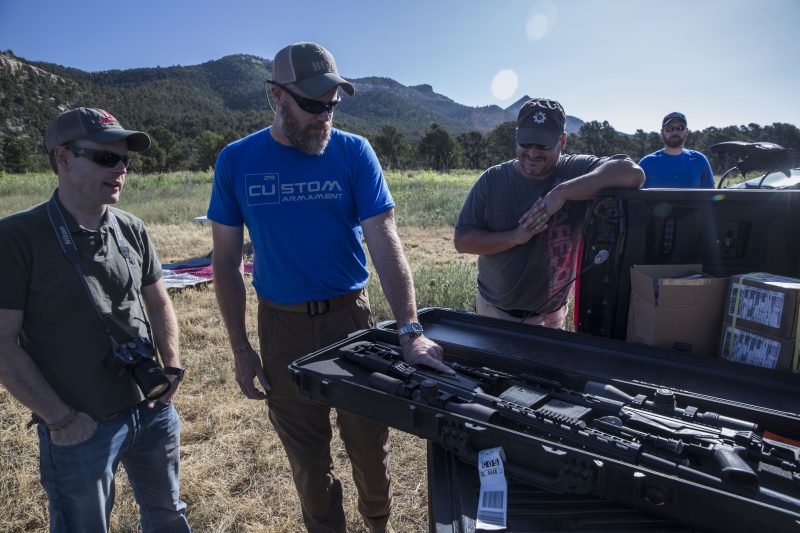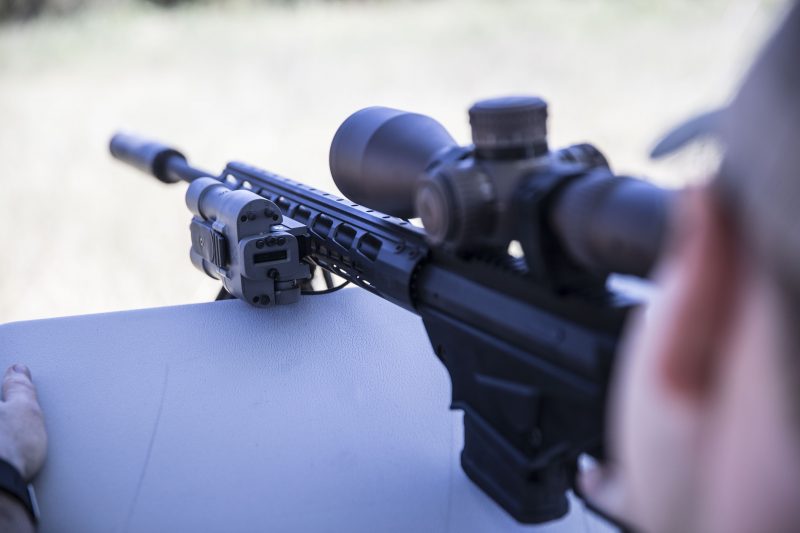Review: SilencerCo SWR Radius Rail-Mounted Rangefinder
OutdoorHub Staff 09.01.16

When I was boarding my flight from South Carolina headed all the way across to country to New Mexico, I didn’t know exactly what to expect. SilencerCo had sent me an invitation to stretch the legs of the newest addition to their product lineup: the SWR Radius.
To be honest, I had some reservations about the entire event – I was told via email that a handful of writers, videographers and other content creators would be attending some long-range shooting events, then utilizing that knowledge combined with the new product, to shoot prairie dogs.
What was I worried about?
While I’ve shot out to 900 yards in the past, I regularly limit my long-range shooting to distances within 500 yards. The reason is simple: The area of South Carolina where I live is either heavily wooded, or swampland. Neither of these climate zones lend themselves to long-range shooting. As such, my skills were a little rusty.
With these thoughts still racing through my brain, I grabbed my rental car and headed off into the New Mexico desert, my truck ploughing through thick clouds of various insects on the dimly lit highway. After 3 hours I arrived at the T.O. Ranch, my vehicle’s white paint looking more like Flecktarn camo, but no worse for wear.
Navigating a pair of excited black Labs, I sat down at a massive oak dinner table and picked up a familiar light grey box. This little aluminum rectangle is accented with small black anodized screws, matching levers and a pair of glass eyes that look like they belong on a smart-bomb’s guidance system.


Enter, the Radius.
Despite its small size, the Radius packs an impressive suite of functions and capabilities that allow shooters to instantly measure the distance to a target at the push of a button. If you’ve ever used a rangefinding binocular or a handheld unit, you’ll feel right at home with the Radius. Though unlike both of these devices, the Radius allows shooters to stay on their rifle while ranging a target.
The Radius is designed to be mounted on a rifle, but I didn’t think the ranch owners would appreciate a stranger walking around in the dark pointing a rifle at various livestock. So I picked up the device, and played with it for a few minutes both inside and out.
I tagged targets such as old trees, barns and jackrabbits in the moonlight out to 300 yards. While this didn’t tell me much about the device other than how it works, it did illuminate one feature that really sets it apart from the competition. Unlike the majority of rangefinders on the market, the Radius can look past small targets and give the shooter multiple range estimates.
So while this may seem almost like a counter-productive feature, it’s actually incredibly useful. For instance, while I was playing around the device, I aimed it at a barn about 350 yards away through the ledge of a field of tall grass. The Radius displayed both the distance to the grass line, as well as the barn. That way if you’re hunting smaller game, you can know both the distance to the target as well as what lies beyond. Also, this allows the Radius to give more accurate distance calculations to targets partially obscured by tall grass or other foliage.
Impressed with the features and idiot-proof setup of the Radius, I headed to bed in anticipation of the next day’s events.

Fire in the Hole!
After gearing up, the lot of us headed out with some guys from SilencerCo to the NRA Whittington Center in Raton, NM. The massive complex puts everything gun range or shooting facilities I’ve ever visited to shame. Best of all, the staff prepared a shooting area for us to use the Radius on that allowed for shots up to 1,450 yards!

But to reliably hit targets that far out, we needed a flat-shooting round and an accurate rifle to launch it from. Thankfully, SilencerCo brought out several Ruger Precision Rifles chambered in 6.5 Creedmoor, topped with Omega sound suppressors.
Every writer grabbed one to try out, and we got ready to zero the Radius on the rifles. Which brings up an interesting part of using the Radius. It must be zeroed differently depending on where it’s mounted on the rifle. Since the Radius utilizes a Picatinny rail mount, it can be mounted beside or above the optic of choice.

Once a shooter has decided where they want to mount the Radius, they measure the distance and angle from it to their riflescope. After that, you head downrange and place a reflective piece of tape at the same angle and distance from the center of the target. To zero, simple hold the scope on the bullseye, and adjust the laser on the Radius so it illuminates the tape. Once that happens, you’re done. It sounds a little complicated, but it’s very easy and takes roughly 5 minutes.

After we got dialed in, every shooter was handed a dope sheet for the 6.5 Creedmoor round, and we began identifying steel targets on the side of a mountain – seriously, that was our backstop. These steel plates were placed a few hundred yards apart, at distances from our shooting platform ranging from 500 to 800 yards away. At these distances, a simple error in range estimation means missing a target by yards, not inches.

Once it was my turn, I laid out on an angled folding table and laz’d my first steel target at 500 or so yards. I glanced down at the Hornady Ballistic Band that I had copied my dope sheet to, and adjusted my Vortex scope by a handful of mil-radians. I emptied my lungs with a powerful, steady exhale and then gently squeezed the trigger.
The dusty target silently shed some of its collected dirt. A half-second later, the telltale ring of lead on steel confirmed what my eyes had seen – a solid hit. The 140-grain ELD Hornady round defied all the rough crosswinds and angrily slammed into the target – further cementing the round’s legendary accuracy.
Surveying the distant mountainside, I spotted another steel target roughly the size of a washing machine at 700 yards, and effortlessly engaged it with the precision rifle. The Radius was giving incredibly precise information, allowing me to dial in the holdovers necessary with confidence.
By the end of the day, SilencerCo reps had given up on calling out the laughably easy steel targets, and instead had us blasting rocks off the cliff sides. Even these small targets were easy prey for the rangefinding Radius. The shot of the day belongs to Tim Harmsen of Military Arms Channel fame, and myself. We spotted a large rock baring a striking resemblance to an EOTech holosight body past the range of the Radius.
Initially I was stumped, but by ranging nearby targets and with the help of a good dope sheet, ranging the rock wasn’t as difficult as I had anticipated. After a few simple calculations greatly aided by the Radius, we estimated the target at 1,400 yards.
After taking a few breaths and waiting for the crosswinds to settle, I squeezed the Ruger Precision Rifle’s trigger, and sent a singular 6.5 Creedmoor round some 1,400 yards to the rocky target.

No Radius = Many Misses
The next day we were due to visit a local farm with a terrible prairie dog problem, but unfortunately prior obligations forced me to depart beforehand. Oddly enough, I was headed across the country to South Dakota on a different prairie dog hunt, and that’s when the true value of the Radius became painfully apparent.
Attempting to engage small targets at unknown distances caused me to overshoot several targets during that hunt – the vast majority of which were within 200 yards. This was in stark contrast to the trip before, where engaging targets at 500 yards felt trivial thanks to the Radius.
While the prairie dog shoot was still wildly successful, I couldn’t help but feel like I was hunting with one hand tied behind my back. If I could have done it over again, I would have brought the Radius along with me to the sweeping plains of South Dakota.
If I were to take a hunting trip to Alaska, the mountains or any place where a long-range shot might be the norm, I would feel remiss not bringing the SWR Radius along with me. At $999.99 it’s certainly not cheap, but consistently harvesting game in the most ethical manner possible is worth every penny.
P.S. The second part of my SWR Radius review is a soon-to-be-released video. You’re not going to want to miss it. Watch for it next week on OutdoorHub!


